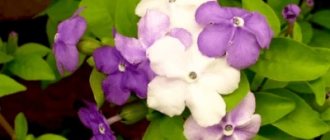Stephanotis still stands apart in the world of ornamental plants, and few gardeners decide to purchase this plant for propagation and care at home, in a greenhouse or in a garden.
But in vain. This semi-shrub vine is a real miracle of nature. And it’s not just about appearance, although appearance is her main trump card.
Long stems, attached to a support, shoot upward and release numerous opposite-growing leaves: elastic, slightly pointed, with a beautiful glossy shine. And from the beauty of the flowers, blooming in abundance here and there, the heart swells with delight.
Popular varieties and their photos
There are few species - only 16. Below are the names, descriptions and photos of the main varieties of stephanotis (floribunda, variegated, variegated), for propagation and care at home.
The name is translated as “pig ears,” probably due to its external resemblance to hoyas. However, among the people, stephanotis was awarded a more elegant name - “Madagascar jasmine”. The homeland of the exotic is Madagascar, the Malay Archipelago, Japan, China. Belongs to the Lastovniev family and was first described in 1806.
Floribunda
The most popular for propagation and care at home is Stephanotis floribunda (Stephanotis Floribunda). Outwardly it looks like a climbing shrub; in the wild it grows up to 5 meters in height. The leaf blades grow opposite each other, they are oval, pointed, entire, dark green in color and with a beautiful shine. The flowers are large, pure white, collected in false umbels (5 cm wide and 4 cm long) and smell very pleasant. It grows well both in homes and in greenhouses and winter gardens.
Photo of flowering variety Floribunda
Variegated
Stephanotis variegata is also suitable for home cultivation, but it is very different from the above-mentioned species - it is not so beautiful in appearance. Its large leaves are covered with white and yellowish spots along the edges, the stems are thick and strong.
Akuminata
Stephanotis acuminata is the most demanding of all varieties. Only a professional gardener with great patience can grow it, capable of creating all the necessary conditions for this capricious exotic. The flowers of akuminata are not white, but cream, more elongated and small.
Photo of flowering variety akuminata
Description
The perennial climbing vine Stefantis belongs to the Lastonaceae family and grows up to 6 m.
Characteristic features of the flower:
- The stem is flexible and elastic in a young plant, but becomes woody over time.
- The leaves are large, up to 12 cm, oval in shape with a sharp tip and a bright vein in the center. The smooth, leathery, emerald or variegated leaves are very attractive, with long stems.
- Flowers have five petals, resemble a star in appearance, and are collected in racemes. White, purple or yellow, they exude a delicious aroma.
- The fruits do not appear often, even in nature, they look like a two-part box with seeds, which opens after ripening and seeds fly out of it like miniature parachutes.
Care
Priming
The soil is suitable for universal and special purposes for semi-shrub vines. Both of them can be bought at any flower shop. But it’s easy to make the mixture yourself.
Get and mix the necessary ingredients : humus (1 part), sand (1 part), deciduous soil (3 parts) and clay-turf soil (2 parts). Instead of humus, you can use finely ground pine bark. It wouldn't hurt to add a handful of bone meal. Be sure to treat the prepared mixture against pests. This can be done in several ways.
Freezing
Wrap the soil in a cloth bag and put it in the freezer for a week, then take it out into the heat for a week and repeat the freezing procedure. This will help destroy pest eggs, but will not save you from late blight.
High temperature action
Use the oven: spread a thin layer of soil on a baking sheet and bake for half an hour at a temperature of 90 degrees. The second option is more gentle - steaming over a bucket of water. Wrap the soil in a cloth bag, place it on a grate, and place the grate on a bucket of water on the stove. Steaming time is at least 90 minutes. These two methods work well against pests, but deteriorate the quality of the soil, so immediately after treatment, apply bacterial fertilizer.
Treatment with chemicals
You can use the usual potassium permanganate (for 10 liters of water - 3-5 g of crystals at the rate of 30-50 ml per square meter of soil), but fungicides "Barrier", "Planriz", "Extrasol", "Glyokladin" and insecticides have proven themselves
“Aktara”, “Iskra”, “Thunder”, “Inta-vir”. Before use, carefully read the instructions and strictly follow the dosages.
Don't forget about drainage: pebbles, broken bricks, expanded clay. Treat it in the same way as soil. The drainage percentage is 20% of the height of the pot.
Permissible acidity – 5.5-6.5 pH
What kind of pot does a flower need?
When choosing a pot, it is better to choose a ceramic container. With good care, Stefanotis grows quickly and is capable of overturning a container made of lighter material (plastic, for example). Before planting, be sure to soak in water for 2-3 hours (to remove harmful substances and gases), wash thoroughly with soap and water and pour over boiling water. If you are using an old pot in which something has already grown before, after washing, douse it with hot water and baking soda.
Lighting
Stephanotis loves light, but does not like direct sun - its rays burn the leaves. And, strange as it may sound, excess light causes the plant to slow down its development rate. Therefore, choose window sills for planting - a western or eastern window will do. The southern one is also possible, but prepare a screen or thick curtains for shading.
On cloudy autumn days and throughout the winter, it is necessary to use backlighting. Install 30-watt fluorescent light bulbs on the sides of the plant (at a distance no closer than 20 and no further than 25 cm).
Temperature
The standard temperature regime of a modern apartment or private house is quite satisfactory for the Madagascan exotic. Maintain readings from +14 to +25 degrees .
In summer they are increased, and in winter they are decreased. It is this wintering that helps stephanotis bloom for a long time. On warm spring and summer days, take the pot out into the garden or onto an open balcony to soak up the fresh air. However, beware of drafts and strong winds - the plant does not like them. This also applies to sudden temperature changes.
How to water?
Stephanotis loves water, but watering must be organized wisely. Make sure the soil in the pot is dry before watering it properly. Usually this needs to be done once every three to four days.
Be careful during the period when the heating is turned off, when the temperature fluctuations in the room and outside are constant, and the humidity also changes. Do not let the soil get wet from your excessive generosity! It is easier for Stephatonis to survive slight drying out of the soil than flooding.
Water for irrigation should be at room temperature and soft . Do not use tap liquid - it contains too much bleach and salts. Leave the water to stand for a day before watering, pouring it into a container without a lid.
Maintain air humidity at a certain level, it is especially important to do this during the heating season. Heat from radiators does not benefit stephanotis, so pamper your pet with a warm shower several times a week (wrap the pot in plastic so as not to flood the soil), place a household humidifier nearby, place a saucer of water on the windowsill, or cover the radiator with a damp towel.
Top dressing
Stephanotis needs to be fed in spring and summer, once every two weeks. In March-April, the amount of fertilizer increases: dissolved cow manure or phosphate. From September to March there is no need to apply fertilizer.
Transfer
Stephanotis should be replanted after purchase immediately after the quarantine period, since store-bought soil is not suitable for further cultivation.
Since the best time for stephanotis to take root is spring, wait to purchase a flower until then. Replanting should be done using the transshipment method : keeping the earthen ball, watering 2-3 days after the procedure.
Other transplants are carried out as needed, but preferably no more than once every 2 years. Be sure to install a strong support so that the vine can gain a foothold on it and develop to its full potential.
Trimming
Stephanotis should be pruned every spring because flowers appear only on young shoots. The procedure is carried out immediately after transplantation, using a disinfected stationery blade. You can't use scissors - they will ruin the stems!
in winter
Winter for Madagascar jasmine is a period of rest and strengthening of the immune system . Water it carefully, protect it from the dry air of batteries and do not disturb it with fertilizing.
Stephanotis transplant
The optimal period for transplanting stephanotis is early spring, before the buds appear. Young plants are transplanted into larger diameter containers annually. The transfer method is used.
Adult flowers can be replanted once every two or even three years.
Stephanotis grow best in large pots made of ceramic. It is important to choose heavy containers, otherwise an adult plant will easily overturn the flowerpot. A heavy pot is a kind of support for the bush.
At the bottom of the container it is necessary to lay out a good layer of drainage, which will facilitate the flow of water.
The method of transshipment for plant replanting was not chosen by chance. The root system of stephanotis is formed by a large number of small roots, which, if handled carelessly, are easily deformed and damaged. As a result, the plant is deprived of the ability to receive water and nutrients from the soil, and this leads to the withering of the bush. The problem can be solved by spraying so that moisture reaches the plant not through the root system, but through the leaves.
Watering in the first few weeks after transplanting should be very careful. Excessive moisture contributes to the death of the entire plant. To speed up the rooting of stephanotis, growth stimulants can be added to the water.
Reproduction
Cuttings
The best option for propagating stephanotis is by cuttings.
- Cut off young upper shoots from the plant several internodes long.
- Treat the cut areas with crushed activated carbon, root or epin, and plant in the prepared container. The soil for the container is a mixture of sand and peat.
- Organize a greenhouse: cover the container with plastic film or glass, and place it in a warm place, bright, but protected from direct sunlight. The temperature for growing is not lower than +27 degrees, arrange bottom heating if necessary. Ventilate the greenhouse every day, loosen the soil little by little and water it carefully.
- When the first roots appear, transplant the cuttings into separate pots.
Instead of soil, you can use water for propagation. The shoots are placed in cups with fresh water (the cuttings should have 2-3 node buds), a greenhouse is set up and germinated on the windowsill. With the appearance of the first roots, stephanotis is transplanted into light soil until new leaves appear, and then to a permanent place of residence.
Seeds
It is possible to grow stephanotis from seeds, but this process is so labor-intensive and time-consuming that only professionals do it. The seeds of the plant are formed in oval boxes , from which they fly out as soon as it dries and cracks. However, this almost always happens only under natural conditions.
- Buy seeds only from a trusted store. Be sure to check the expiration date, check the integrity of the packaging and the quality of the seed material. Pour the seeds into a glass of salted water and stir with a spoon: the empty seeds will rise to the top. Collect them and throw them away.
- Seeds, like cuttings, are planted in a greenhouse, in soil made of peat and sand. Sow not too thickly and without digging into the soil (it is enough to press 1 cm). The first shoots should appear in two weeks, and after another 10-14 days the sprouts will be ready for transplanting into separate pots.
Pests
All house plants suffer from spider mites and stephanotis is no exception . This little bug is extremely fertile and tenacious, sucking sap from the plant at a sprinting speed and adapting to poisons. Destroying it is not easy. It lays eggs not only on leaves and the ground, but also in the cracks of window sills and frames, and on greenhouse trellises.
Signs of damage are the appearance of white, gradually darkening spots on the leaves, cobwebs entangling the trunk and cuttings, wilting of greenery and buds, poor growth.
Appears in dry air as a result of improper care (at humidity above 80% the tick dies).
First, rinse the flower in the shower, covering the soil with film. This will help get rid of the adults. After: remove withered leaves and stems, and use any folk remedy (provided that the plant is not badly damaged): turpentine, garlic and onion pulp, a solution of green or tar soap, infusion of dandelion or calendula.
If there are a lot of pests, chemicals (Apollo, Nissoran, Oberon, Flumite, Sunmite, Floromite, Kleschevit) or biological products (Aktofit, Vertimek, Akarin) can help ", "Fitoverm"). Number of treatments – at least 3 with an interval of 3-6 days.
Aphids are an equally dangerous enemy for stephanotis. It prefers young plants because it is not able to pierce a hard leaf plate with its proboscis.
Brown spots appear on the leaves, the plates become deformed, become covered with honeydew, and gradually with sooty fungus.
Among the folk remedies, a soap solution (4-5 tablespoons of soap shavings per liter of warm water), an infusion of ash (a handful per 5 liters), and tobacco infusion (infuse a glass of shag in 5 liters of boiling water for 24 hours) help well. Chemicals: Karbofos, Aktara, Intavir. Remember: young plants may die from treatment with chemicals, so in case of mass damage, propagate by cuttings.
Diseases
- If the buds of stephanotis wither and fall off, you either did not protect it from a draft or did not add water when watering.
- What to do if the leaves turn yellow? Yellowing of leaves has several causes. The problem may be a lack of light, too hard water or low temperature. Lack of drainage in the pot, stagnation of moisture, and lack of nutrients also have a negative effect.
- Why does stephanotis not bloom and what to do in this case? The plant does not want to bloom for the following reasons: the flower does not receive enough nutrition or light. And don’t forget to provide the vine with a comfortable winter!
If you notice that stephanotis has decided to produce buds, do not move it to another place. During the budding period, the plant is especially vulnerable and will refuse to bloom if disturbed.
Stephanotis flowers smell wonderful, but prolonged inhalation of the aroma can cause headaches , dizziness and nausea, so it is better to take the flowering plant out of the bedroom at night.
Types in the table
The most popular types for indoor growing:
| Name | Peculiarities |
| Floribunda (profusely blooming). | White flowers, up to 6 cm in diameter, resemble stars in shape. |
| Variegata or variegated. | It differs in the color of the leaves - it has stripes and white, yellow or green spots. The leaves are slightly rounded. |
| Akuminata. | It has cream-colored flowers. |
| Grandiflora. | It has a larger inflorescence of 30 flowers than other species. |
| Thorsia. | It has a larger inflorescence of 30 flowers, pinkish in color, than other species. |
Can I keep it at home?
Stephanotis, according to legend, negatively affects male energy, weakens it and makes a man lazy and lethargic. Therefore, you should not place the plant in his office, for example, or on his side of the bed. Otherwise, there are no prohibitions or restrictions.
The juice is very caustic and, if it gets into the eyes or on the skin, can cause severe irritation and often a burn.
Therefore, when replanting, propagating or simply inspecting the plant, prepare thick gloves and make sure that the juice does not splash into your eyes. For the same reason, keep small children and pets away from stephanotis.
Formation of a stephanotis bush
The plant needs minor pruning before replanting. You should also cut off dried inflorescences, this way the plant will have the strength to grow and develop.
Stephanotis shoots quickly grow in length. That is why it is so important to promptly organize support for the branches or put them along an arched support. If a flower grows in a greenhouse or winter garden, the length of its shoots can reach five or even six meters.
Signs and superstitions
Stephanotis is considered not only beautiful, but also a truly feminine flower. It is believed that the plant prolongs youth and does not allow beauty to wither, giving charm and femininity to its owner. In Madagascar, there has long been a custom of giving an unmarried girl stephanotis , which, according to legend, will lure female happiness and a good groom to the house with its flowering. And at least one flower must be inserted into the wedding bouquet, then the feelings between the spouses will not cool down, and the marriage will be happy and long.
Why doesn't jasmine bloom?
Sometimes it happens that stephanotis does not bloom. What should novice flora fans do in such cases? After all, the overseas vine is valued precisely for its luxurious buds.
Experts name several reasons:
- lack of lighting (the crop is located deep in the living room or on the north window);
- the pot is too big;
- poor feeding.
It seems that by eliminating these shortcomings, the plant will present the owner with a wreath of exquisite buds. However, this is not always the case. Therefore, beginners are thinking about how to make stephanotis bloom all 10 months of the year.
How to make it bloom
Experts advise:
- provide the culture with complete rest in autumn and winter;
- make sure that the container matches the size of the root system and completely envelops the earthen ball;
- Regularly apply fertilizers to stimulate the appearance of buds.
Photo gallery
sultanova_sad
tsvetochnyj_raj_kirov
soloma31rus
marianisenbaum
flora_florastrakhan
sashalupu











